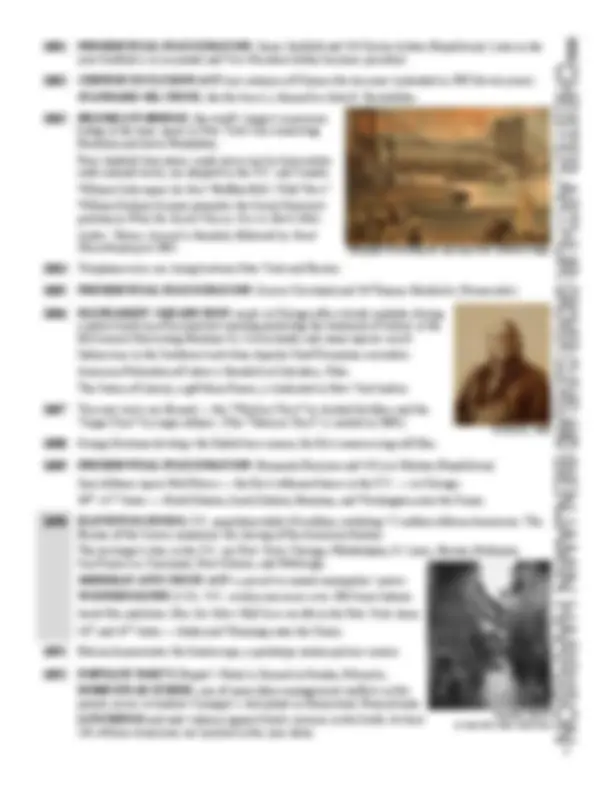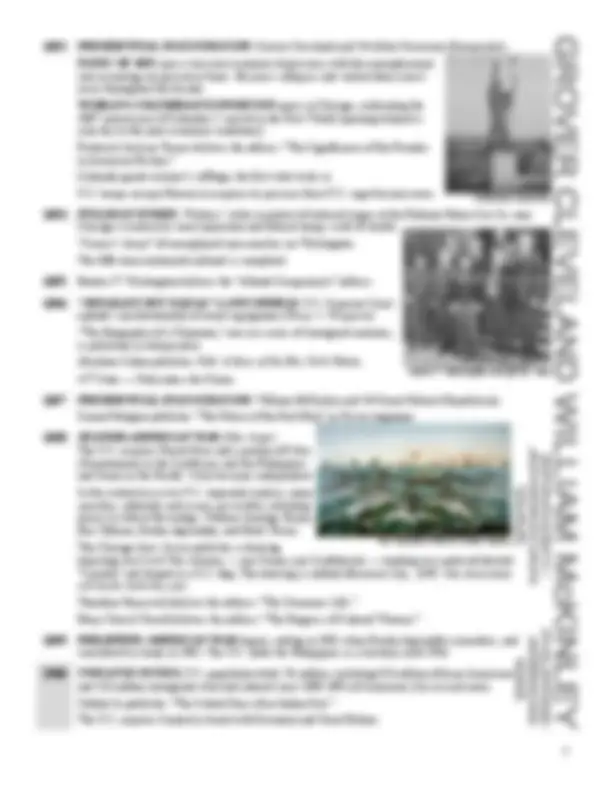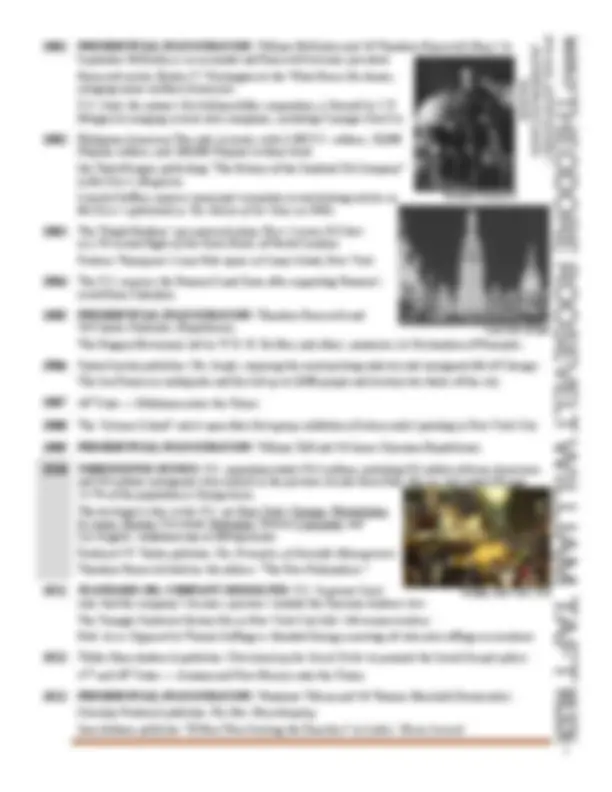





Study with the several resources on Docsity

Earn points by helping other students or get them with a premium plan


Prepare for your exams
Study with the several resources on Docsity

Earn points to download
Earn points by helping other students or get them with a premium plan
Community
Ask the community for help and clear up your study doubts
Discover the best universities in your country according to Docsity users
Free resources
Download our free guides on studying techniques, anxiety management strategies, and thesis advice from Docsity tutors
Significant historical events during the Civil War and Progressive Era in the United States. Topics include the abolition of slavery, the formation of major businesses, key literary works, population growth, and the acquisition of territories. Notable figures include Abraham Lincoln, Andrew Johnson, Ulysses S. Grant, and Theodore Roosevelt.
What you will learn
Typology: Lecture notes
1 / 5

This page cannot be seen from the preview
Don't miss anything!




accompanying the Seminar Toolbox “The Gilded & the Gritty: America, 1870-1912”
National Humanities Center
CIVIL WAR ENDS. Of approximately 3.7 million troops, 365, Union and 258,000 Confederate soldiers are dead (app. one third in battle; estimates vary). Surviving veterans return home. LINCOLN IS ASSASSINATED in Washington, D.C. Vice-President Andrew Johnson becomes President. 13 th^ AMENDMENT bans slavery in the U.S. Four million enslaved African Americans are freed.
First refrigerated railroad car in America, with ice “bunkers” at each end, is constructed in Detroit. Andrew Carnegie and his partners form businesses in the iron industry, including the Pittsburgh Locomotive Works in 1866 and the Union Iron Mills in 1867.
U.S. purchases Alaska from Russia for $72 million. 37 th^ State Nebraska enters the Union.
and guarantees “equal protection of the laws” to all U.S. citizens. Attempt to impeach President Johnson fails by one vote.
VP Schuyler Colfax (Republican). FIRST TRANSCONTINENTAL RAILROAD. Union Pacific and Central Pacific RR’s link in Utah. First “Black Friday”: stock market panic results from financiers’ attempts to corner the market on gold. Wyoming Territory grants suffrage to women; Utah Territory in 1870. In this period, Albert Bierstadt and others create visions of the American West in dramatic landscapes.
4.9 million African Americans and 2.3 million immigrants who had arrived in the previous decade. 15 th^ AMENDMENT grants suffrage to African American men. STANDARD OIL COMPANY OF OHIO is formed by John D. Rockefeller from several smaller companies, soon controlling 10% of the oil refining industry in the U.S.
recognizing Indian tribes as sovereign nations and negotiating through treaties, announcing it will make Indian policy through law and executive decision. Native Americans legally become wards of the nation.
construction of the transcontinental railroad. Montgomery Ward & Co., the first mail-order business, opens in Chicago. (Sears opens in 1895.)
Bierstadt, The Oregon Trail , 1869
Homer, The Veteran in a New Field, 1865
Does not such a meeting make amends? , 186 9
FINANCIAL PANIC OF 1873 begins a five-year economic depression after the failure of Jay Cooke’s investment bank. Congress makes gold the national standard and eliminates all silver currency. Bethlehem Steel Company in Pittsburgh begins producing steel rails with the Bessemer process. Period of recurring epidemics beginning in 1865 comes to an end. From Boston to New Orleans, epidemics of smallpox, cholera, typhus, typhoid, scarlet fever, and yellow fever had killed thousands. The first electric streetcar begins operation in New York City. Free mail delivery begins in all cities above 20,000 population. Mark Twain and C. D. Warner publish the novel The Gilded Age.
The Virginian (1902), arrives in Wyoming Territory. Massachusetts limits women’s working hours to ten hours a day. is passed in Massachusetts.
the former Confederacy.
the 100th^ anniversary of the Declaration of Independence. LITTLE BIG HORN (Montana): Sioux and Cheyenne Indians attack and kill General George Custer and 274 cavalrymen. 38 th^ State Colorado enters the Union. Alexander Graham Bell demonstrates and patents the telephone.
presidential election. U.S. troops leave the South, ending the occupation of the former Confederacy and the protection afforded the freed slaves. PRESIDENTIAL INAUGURATION. Rutherford Hayes & VP Wm. Wheeler (Rep.) GREAT RAILROAD STRIKE OF 1877. After West Virginia railroad workers strike to protest wage reductions, sympathy strikes and violence spread across the Midwest. Federal troops break the strikes. Rockefeller’s Standard Oil controls almost 90% of the U.S. oil refining industry. Governmental regulation of business to protect the public interest is ruled constitutional by the U.S. Supreme Court ( Munn v. Illinois ). Nez Percé Indians, led by Chief Joseph, surrender after a 1600-mile trek retreating from U.S. troops through the U.S. northwest. They are sent to a reservation in Indian Territory (Oklahoma). Thomas Edison patents the phonograph.
Frank Woolworth opens the first five-and-ten-cent store (Pa.) Carlisle School (Pa.) is opened “Americanize” Indian children.
including 6.6 million African Americans. George Pullman builds a model town for employees of his Pullman Palace Car factory outside Chicago. Land disputes between farmers and the railroads in California lead to the Mussel Slough shoot-out, fictionalized by Frank Norris in his 1901 novel The Octopus.
Thomas Edison
Pullman Palace Car Co., main gate
1876 Centennial Exposition, Philadelphia
PANIC OF 1893 spurs a ten-year economic depression, with the unemployment rate exceeding ten percent at times. Business collapses and violent labor unrest occur throughout the decade. WORLD’S COLUMBIAN EXPOSITION opens in Chicago, celebrating the 400 th^ anniversary of Columbus’s arrival in the New World (opening delayed a year due to the poor economic conditions). Frederick Jackson Turner delivers the address “The Significance of the Frontier in American History.” Colorado grants women’s suffrage, the first state to do so. U.S. troops occupy Hawaii in response to pressure from U.S. sugar businessmen.
Chicago is broken by court injunction and federal troops, with 34 deaths. “Coxey’s Army” of unemployed men marches on Washington. The fifth transcontinental railroad is completed.
upholds constitutionality of racial segregation ( Plessy v. Ferguson ). “The Biography of a Chinaman,” one in a series of immigrant memoirs, is published in Independent. Abraham Cahan publishes Yekl: A Story of the New York Ghetto. 45 th^ State Utah enters the Union.
Simon Pokagon publishes “The Future of the Red Man” in Forum magazine.
The U.S. acquires Puerto Rico and a portion of Cuba (Guantanamo) in the Caribbean, and the Philippines and Guam in the Pacific. Cuba becomes independent. In the controversy over U.S. imperialist policy, many speeches, editorials and essays are written, including pieces by Albert Beveridge, William Jennings Bryan, Ben Tillman, Emilio Aguinaldo, and Mark Twain. The Chicago Inter Ocean publishes a drawing depicting two Civil War veterans one Union, one Confederate standing on a pedestal labeled “Loyalty” and draped in a U.S. flag. The drawing is entitled Memorial Day, 1898: One decoration will do for both this year. Theodore Roosevelt delivers the address “The Strenuous Life.” Mary Church Terrell delivers the address “The Progress of Colored Women.”
concluded by treaty in 1902. The U.S. holds the Philippines as a territory until 1946.
and 3.6 million immigrants who had entered since 1890. 60% of Americans live in rural areas. Zitkala Sa publishes “The School Days of an Indian Girl.” The U.S. acquires Samoa by treaty with Germany and Great Britain.
Booker T. Washington and guests, 1906
Our Victorious Fleet in Cuban Waters
Columbian Exposition
September McKinley is assassinated and Roosevelt becomes president. Roosevelt invites Booker T. Washington to the White House for dinner, enraging many southern Americans. U.S. Steel, the nation’s first billion-dollar corporation, is formed by J. P. Morgan by merging several steel companies, including Carnegie Steel Co.
Filipino soldiers, and 200,000 Filipino civilians dead. Ida Tarbell begins publishing “The History of the Standard Oil Company” in McClure’s Magazin e. Lincoln Steffens exposes municipal corruption in muckraking articles in McClure’s (published as The Shame of the Cities in 1904).
in a 59-second flight on the Outer Banks of North Carolina. Frederic Thompson’s Luna Park opens in Coney Island, New York.
revolt from Colombia.
VP Charles Fairbanks (Republican). The Niagara Movement, led by W. E. B. Du Bois and others, announces its Declaration of Principles.
The San Francisco earthquake and fire kill up to 3,000 people and destroy two thirds of the city.
and 8.8 million immigrants who entered in the previous decade from Italy, Russia, and central Europe. 14.7% of the population is foreign born. The ten largest cities in the U.S. are New York, Chicago, Philadelphia, St. Louis, Boston, Cleveland, Baltimore, Detroit, Cincinnati, and Los Angeles. (underlined cities in 1890 top-ten list) Frederick W. Taylor publishes The Principles of Scientific Management. Theodore Roosevelt delivers the address “The New Nationalism.”
rules that the company’s business practices violated the Sherman Antitrust Act. The Triangle Shirtwaist factory fire in New York City kills 146 women workers. Natl. Assn. Opposed to Women Suffrage is founded during a meeting of state anti-suffrage associations.
47 th^ and 48th^ States Arizona and New Mexico enter the Union.
Christine Frederick publishes The New Housekeeping. Jane Addams publishes “If Men Were Seeking the Franchise” in Ladies’ Home Journal.
Theodore Roosevelt
Bellows, New York, 1910
Luna Park at night